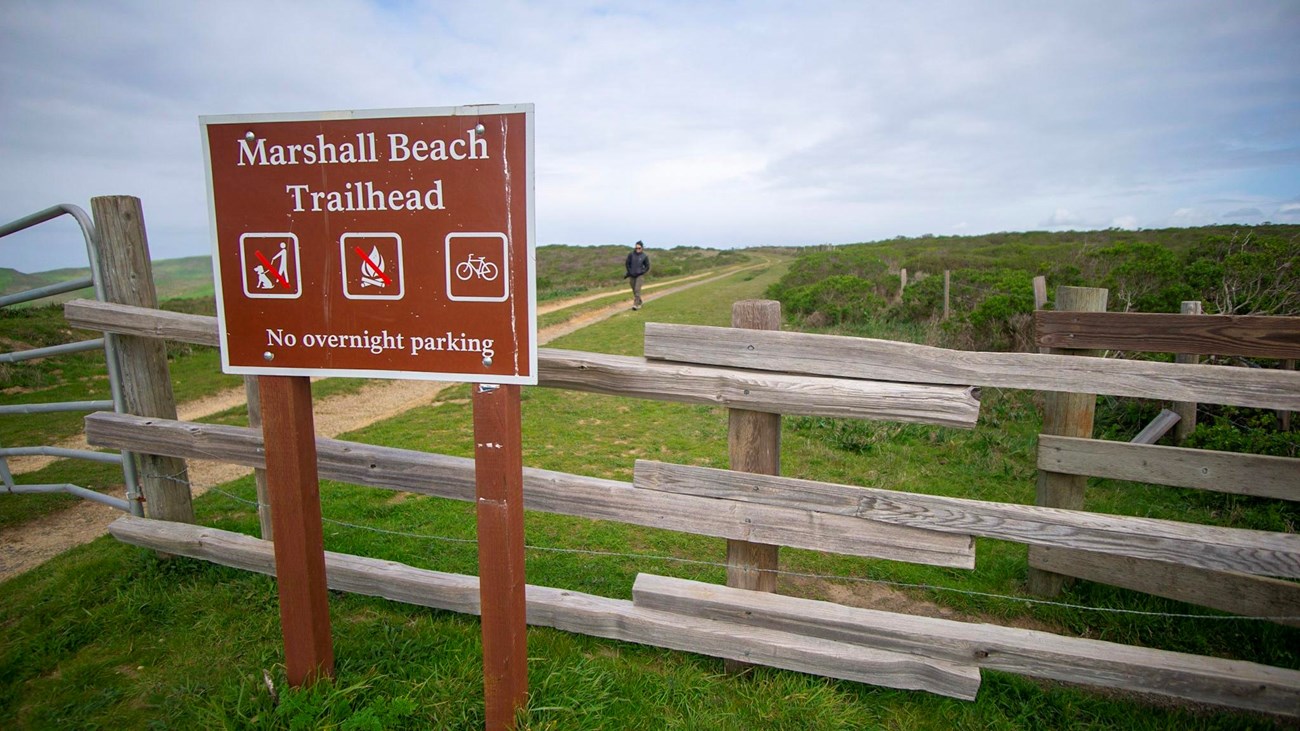Last updated: October 10, 2024
Thing to Do
Hike the Marshall Beach Trail

NPS / A. Kopshever
Distance: 2.4 mi. (3.8 km) roundtrip
Marshall Beach is a 400-foot-long (366-meter-long) beach on the west side of Tomales Bay in the northern part of the national seashore. Most visitors to this beach arrive via water (i.e., by kayak), but visitors may also hike (or ride their bicycles or horses) to Marshall Beach via the 1.2-mile-long (1.9-kilometer-long) Marshall Beach Trail. The Marshall Beach Trailhead is reached by vehicle via L Ranch Road, which is a 2.6-mile-long (4.2-kilometer-long) gravel road.
The Marshall Beach Trail follows the route of an old ranch road, which is now used once a day or so by NPS staff in park vehicles to service the vault toilets at the beach. The first half of the Marshall Beach Trail is mostly level, passing through pasture land along a fence line. After 0.4 miles (0.7 km), the trail passes through a gate in the fence and continues along the fence's eastern side for another 0.2 km (0.3 km) before bending away to the northwest, leaving the pastures behind for coastal scrub. The trail begins to descend gradually at first, but then loses ~300 feet (90 meters) in elevation over the last 0.4 miles (0.7) as the trail hooks to the southeast. The trail enters a grove of pine trees for the final 650 feet (200 meters) before reaching the beach. Vault toilets are located to the right as one approaches the beach. Return via the same trail.
This route description alone is not a substitute for a trail map. Print out the park's North District trail map (3,409 KB PDF) before your visit, or pick one up at a visitor center on your way.
Always check current conditions before heading out into the park and familiarize yourself with park regulations. Please practice Leave No Trace principles.
Visit the park's Hiking at Point Reyes National Seashore page for hiking tips and information about trail etiquette and safety.
Visit the park's Trail Advisories and Closures page for current information about closed trails, trails blocked by trees, or other temporary hazards or advisories.
Allow 50 to 75 minutes to hike to and from the beach. Allow for more time to relax at the beach.
All ages.
Pets are prohibited on the Marshall Beach Trail. Visit the park's Pets page to learn where pets are welcome at Point Reyes National Seashore.
The Marshall Beach Trailhead is reached by vehicle via L Ranch Road, which is a 2.6-mile-long (4.2-kilometer-long) gravel road. Marshall Beach is a 400-foot-long (366-meter-long) beach on the west side of Tomales Bay in the northern part of the national seashore.
Directions to Bear Valley
Directions from Bear Valley to Marshall Beach Trailhead
Winter
The heaviest rainfall occurs in the winter months. Come prepared for rain and drizzle to possibly last for several days. In between winter rains, it is often sunny, calm, and cool.
Spring
Most spring days are windy and Tomales Bay frequently experiences strong breezes, although Marshall Beach is fairly sheltered from the dominant winds that come from the northwest. Expect cool temperatures in March. By late May and early June, temperatures can be quite pleasant, even warm.
Summer
Although there is very little rain during summer months, there is often dense fog throughout the day in July, August and September with temperatures often 20 degrees cooler than at Bear Valley.
Fall
The coastal areas of Point Reyes experience some of the clearest days in late September, October and early November. The occasional storm will start rolling through in late October, bringing clouds, wind, and rain. The strongest winds occur in November and December during occasional southerly gales.
Point Reyes National Seashore is open for day-hiking from 6 am to midnight. Overnight parking at Marshall Beach is prohibited.
The Marshall Beach Trail follows the route of an old ranch road, which is now used once a day or so by NPS staff in park vehicles to service the vault toilets at the beach. So, the trail is fairly wide for its entire length. The first 0.6 miles (1 kilometer) of the trail is relatively flat, but the last 0.6 miles (1 kilometer), gets progressively steeper and more rutted.
